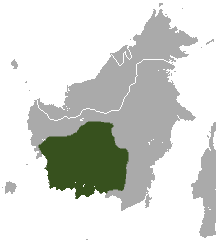| Bornean white-bearded gibbon [1] | |
|---|---|
 | |
| Bornean white-bearded gibbon (Hylobates albibarbis) in Tanjung Puting National Park | |
| Scientific classification | |
| Kingdom: | Animalia |
| Phylum: | Chordata |
| Class: | Mammalia |
| Order: | Primates |
| Suborder: | Haplorhini |
| Infraorder: | Simiiformes |
| Family: | Hylobatidae |
| Genus: | Hylobates |
| Species: | H. albibarbis |
| Binomial name | |
| Hylobates albibarbis Lyon, 1911 | |
 | |
| Range of Bornean white-bearded gibbon (green) | |
The Bornean white-bearded gibbon (Hylobates albibarbis), also known as the Bornean agile gibbon or southern gibbon, is a species of gibbon endemic to southern Borneo. It is an endangered species, due to the ongoing logging of tropical forests between the Kapuas and Barito rivers. [2] Additional issues of concern to the endangerment of white-bearded gibbons also threaten other arboreal primates. [3] [4]
Contents
The white-bearded gibbon is very similar to other gibbons in their behaviour and their frugivorous diet. The Bornean white-bearded gibbon was formerly considered a subspecies of the agile gibbon but based on recent DNA research, some now classify it as a separate species. [1] [4] [5]
